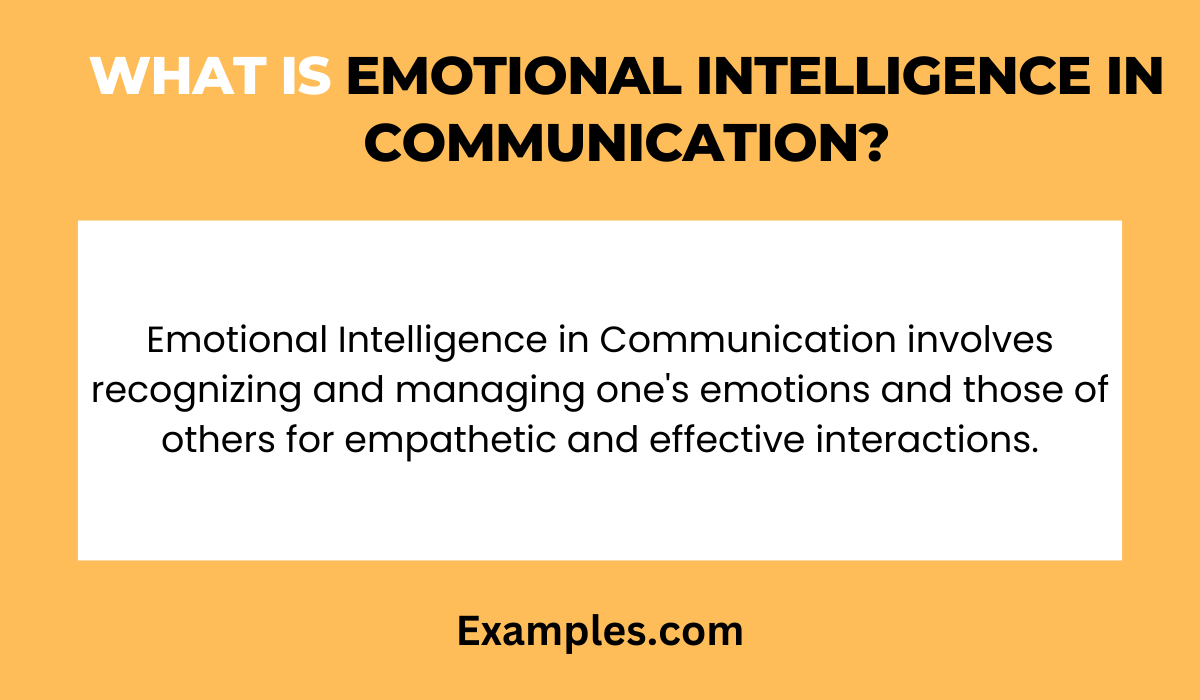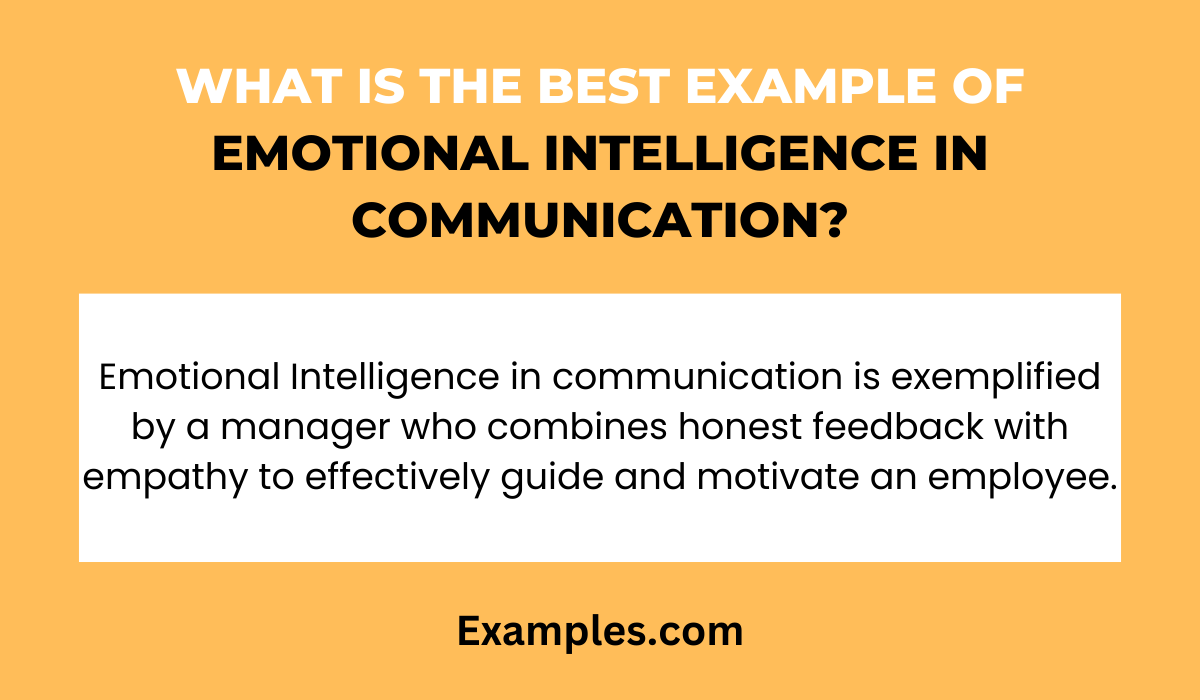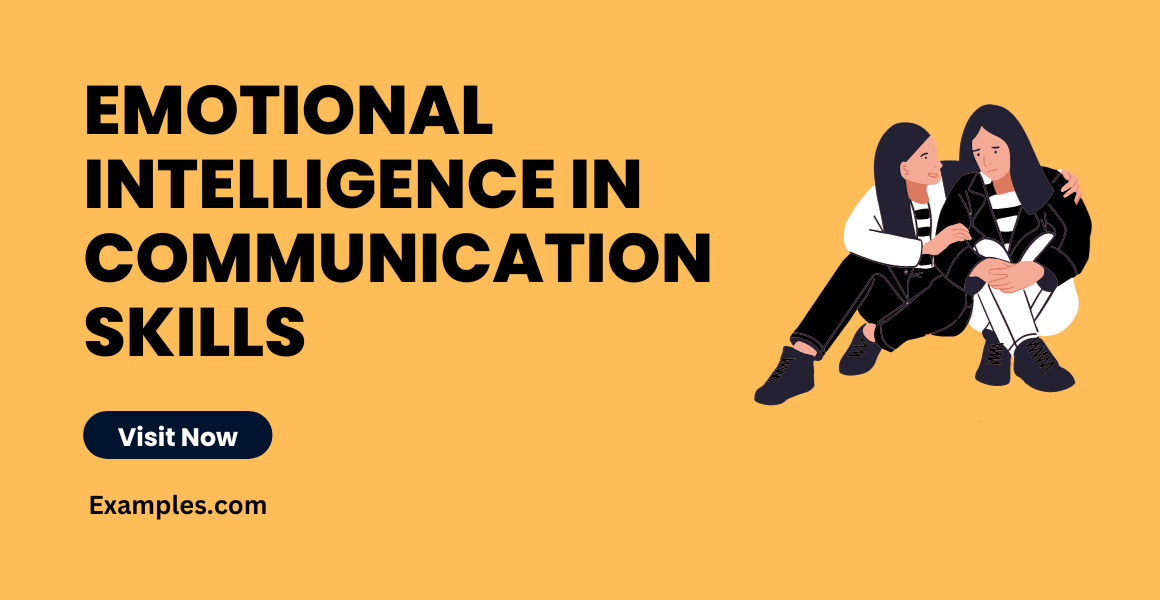Emotional Intelligence in Communication Skills
In the intricate dance of human interaction, Emotional Intelligence in Communication Skills plays a pivotal role. This extensive guide uncovers the layers of emotional intelligence (EI) and its profound impact on communication. Through various Communication Examples, you’ll discover how EI can transform your interactions, making them more effective, empathetic, and meaningful. Whether it’s in a professional setting or personal relationships, these insights and examples will enhance your ability to communicate with emotional intelligence.
What is Emotional Intelligence in Communication?
Emotional Intelligence in Communication refers to the ability to recognize, understand, and manage our own emotions, as well as to recognize and influence the emotions of others. In communication, this means being aware of the emotional context of the conversation and adjusting your approach accordingly to achieve a more effective and empathetic interaction.

What is the Best Example of Emotional Intelligence in Communication?
A prime example of Emotional Intelligence in Communication is a manager giving feedback to an employee. Instead of simply criticizing, the manager acknowledges the employee’s efforts, addresses areas for improvement with sensitivity, and offers constructive suggestions. This approach, which balances honesty with empathy, not only conveys the message effectively but also maintains the employee’s motivation and respect.

30 Emotional Intelligence in Communication:
Emotional Intelligence in Communication is a fundamental skill set for effective interpersonal interactions. This guide explores 30 critical aspects of emotional intelligence (EI), each accompanied by a unique example. From understanding and managing emotions to empathetically engaging with others, these elements enhance the depth and effectiveness of communication. Whether in personal relationships or professional environments, these examples provide practical insights into how EI can be integrated into everyday communication.

- Recognizing Emotions in Others: Understand and acknowledge the emotions others are expressing.
Example: “I see that this topic makes you uneasy. Let’s approach it gently.” - Expressing Empathy: Show that you understand and share the feelings of another person.
Example: “I completely understand why that situation would be frustrating for you.” - Self-Awareness: Be conscious of your own emotions and how they influence your communication.
Example: “I’m feeling a bit stressed today, so I might need a moment to collect my thoughts.” - Managing Emotions: Keep your emotions in check to maintain effective communication.
Example: Feeling annoyed, yet calmly saying, “Let’s find a solution that works for both of us.” - Effective Listening: Listen actively, showing that you are fully engaged and understanding.
Example: “I’m listening carefully, please tell me more about your experience.” - Non-Verbal Communication: Use body language and facial expressions to convey empathy and understanding.
Example: Nodding and maintaining eye contact as the other person speaks.

- Conflict Resolution: Utilize emotional intelligence to navigate and resolve conflicts.
Example: “Let’s try to understand each other’s perspectives and find common ground.” - Building Relationships: Foster strong connections through emotionally intelligent communication.
Example: “I value our relationship and want to understand your point of view.” - Encouraging Openness: Create a safe space where others feel comfortable expressing their emotions.
Example: “Feel free to share your thoughts; I’m here to listen.” - Adapting to Emotional Cues: Change your communication style in response to others’ emotional cues.
Example: Softening your tone when you notice someone is feeling overwhelmed. - Positive Reinforcement: Use positive language to encourage and motivate others.
Example: “You’re doing a great job, and your effort is truly appreciated.” - Respecting Boundaries: Understand and respect the emotional boundaries of others.
Example: “I sense this topic is uncomfortable for you, so let’s switch gears.” - Calmness Under Pressure: Maintain composure in stressful situations to communicate effectively.
Example: In a tense meeting, “Let’s take a deep breath and assess our options.” - Empathetic Feedback: Give feedback that is considerate of the person’s feelings.
Example: “I admire your work on this project. Let’s explore some areas for growth together.” - Cultural Sensitivity: Be aware of and respect emotional norms of different cultures.
Example: “I’m mindful of our cultural differences and want to understand your perspective.” - Authenticity in Communication: Be genuine in your interactions, showing true understanding and care.
Example: “I truly believe in what we are discussing and its importance.” - Emotional Regulation: Control your emotional responses to maintain a constructive conversation.
Example: Feeling frustrated but saying, “Let’s focus on solving this issue together.” - Understanding Emotional Drivers: Recognize the underlying emotions driving others’ behaviors.
Example: “It sounds like you’re worried about this change; let’s address that.” - Perspective Taking: See situations from the viewpoint of others to enhance understanding.
Example: “If I were in your position, I might feel the same way.” - Positive Attitude: Convey a positive, hopeful attitude in your communications.
Example: “Despite these challenges, I’m confident we can find a solution.” - Responding to Emotions: React to others’ emotions in a way that acknowledges and validates them.
Example: “I can see why that would upset you. Let’s work through it together.” - Emotionally Intelligent Leadership: Lead with emotional intelligence to inspire and guide effectively.
Example: “As a team, we’ll navigate these challenges by supporting each other.” - Constructive Criticism: Offer criticism in a way that is helpful and not harmful.
Example: “I have some thoughts on how we can improve this further.” - Emotional Support: Provide support and understanding in emotional situations.
Example: “I’m here for you and ready to help however I can.”

- Humility in Communication: Show humility and openness to learning in conversations.
Example: “I appreciate your feedback and am eager to learn from this.” - Inspiring Trust: Build trust through emotionally intelligent interactions.
Example: “You can count on me to be fair and understanding.” - Balancing Logic and Emotion: Blend emotional understanding with logical reasoning.
Example: “Let’s consider both the emotional and practical aspects of this decision.” - Fostering Cooperation: Use emotional intelligence to encourage teamwork and cooperation.
Example: “By understanding each other’s views, we can work together more effectively.” - Managing Stressful Conversations: Navigate difficult discussions with calm and understanding.
Example: “Even though this is tough to talk about, we can get through it.” - Encouraging Emotional Expression: Promote an environment where emotions can be freely expressed.
Example: “It’s okay to show how you feel; let’s talk openly about it.”
How is Emotional Intelligence Used in Communication?
Understanding How emotional intelligence is used in communication is crucial for meaningful interactions. Emotional intelligence (EI) plays a significant role in how we convey and interpret messages, allowing for more effective and empathetic communication.
- Interpreting Emotions: EI helps in accurately interpreting the emotions behind others’ words.
- Expressing Empathy: It enables individuals to express empathy effectively.
- Managing Personal Emotions: EI involves managing one’s emotions to communicate more clearly.
- Enhancing Listening Skills: EI improves the ability to listen actively and respond appropriately.
- Building Stronger Relationships: EI aids in forming deeper connections through communication.
- Conflict Resolution: It is key in resolving conflicts with understanding and empathy.
- Improving Non-Verbal Communication: EI enhances the interpretation and use of non-verbal cues.
- Facilitating Feedback: EI allows for giving and receiving feedback in a constructive manner.
- Negotiation Skills: Emotional intelligence is critical in negotiating with sensitivity to others’ emotions.
- Adapting Communication Style: EI helps in adjusting communication styles to suit different emotional contexts.
Importance of Emotional Intelligence in Communication
The Importance of Emotional Intelligence in Communication cannot be overstated. It is a vital component that enriches interpersonal interactions, fostering understanding and collaboration.
- Enhances Understanding: EI deepens understanding between communicators.
- Reduces Miscommunication: It helps in reducing instances of misunderstandings.
- Strengthens Relationships: EI is fundamental in building and maintaining strong relationships.
- Improves Conflict Management: It plays a crucial role in managing and resolving conflicts.
- Boosts Persuasion Skills: EI enhances the ability to persuade and influence others.
- Facilitates Teamwork: In team settings, EI is key for effective collaboration.
- Increases Empathy: It allows individuals to communicate with more empathy and compassion.
- Enhances Leadership Communication: Leaders benefit greatly from employing EI in their communication.
- Improves Customer Relations: In customer-facing roles, EI improves interactions and satisfaction.
- Supports Personal Development: Developing EI contributes to overall personal and professional growth.
Role of Emotional Intelligence in Communication
The Role of Emotional Intelligence in Communication is multidimensional, impacting various aspects of how we interact and connect with others. It is an indispensable tool for effective and empathetic communication.
- Facilitating Emotional Understanding: EI helps in understanding both one’s own and others’ emotions.
- Improving Clarity in Communication: EI aids in conveying messages more clearly and effectively.
- Enhancing Social Awareness: It increases sensitivity to social dynamics and cues.
- Supporting Emotional Regulation: EI is crucial in regulating emotions during communication.
- Aiding in Effective Feedback: EI enables giving and receiving feedback positively.
- Promoting Conflict Resolution: It is essential in resolving conflicts with emotional awareness.
- Improving Negotiation Outcomes: EI can lead to more successful negotiation results.
- Fostering Compassionate Leadership: Leaders with high EI can lead with more compassion and understanding.
- Enhancing Customer Engagement: In sales and service, EI improves customer engagement and satisfaction.
- Cultivating Empathetic Relationships: EI fosters deeper and more empathetic personal and professional relationships.
How to Improve Emotional Intelligence in Communication
How to Improve Emotional Intelligence in Communication involves conscious effort and practice. Enhancing your EI can lead to more effective and meaningful interactions, both personally and professionally.
- Practice Self-Reflection: Regularly reflect on your emotional responses and behaviors.
- Develop Active Listening Skills: Focus on truly understanding the speaker’s emotions.
- Seek Feedback: Ask for feedback on your emotional responses and communication style.
- Engage in Empathy Exercises: Practice putting yourself in others’ shoes.
- Learn to Manage Stress: Develop strategies to manage stress and maintain emotional balance.
- Study Body Language: Learn to read and interpret non-verbal cues accurately.
- Expand Emotional Vocabulary: Improve your ability to express emotions clearly.
- Seek Professional Development: Attend workshops or courses on EI and communication.
- Cultivate Mindfulness: Practice mindfulness to enhance your emotional awareness.
- Engage in Constructive Conflict Resolution: Practice resolving conflicts with emotional intelligence.
Tips for Emotional Intelligence in Communication Skills
Mastering Emotional Intelligence in Communication Skills requires understanding and implementing specific strategies. These tips are designed to help you communicate more effectively by leveraging emotional intelligence.
- Be Open to Emotional Cues: Stay receptive to emotional cues in conversations.
- Respond, Don’t React: Take a moment to think before responding emotionally.
- Use ‘I’ Statements: Communicate your feelings without blaming others.
- Practice Empathy: Regularly practice empathy in your interactions.
- Maintain Emotional Balance: Work on keeping your emotions balanced and appropriate.
- Adapt to Different Emotional Contexts: Be flexible in adjusting to various emotional situations.
- Prioritize Active Listening: Show genuine interest in the speaker’s emotions.
- Cultivate Positive Relationships: Build relationships based on mutual understanding and respect.
- Develop Self-Awareness: Continuously work on understanding your emotional triggers.
- Embrace Continuous Learning: Keep learning and growing in your emotional intelligence journey.
In summary, Emotional Intelligence in Communication is a vital skill that enhances the way we interact and connect with others. This guide has provided insights into the importance, role, improvement strategies, and practical tips for incorporating emotional intelligence into your communication skills. By embracing these principles, you can significantly improve your interpersonal interactions, leading to more fulfilling and effective communication experiences.



